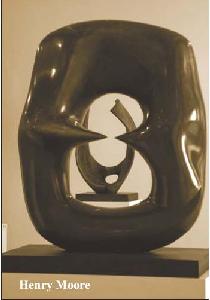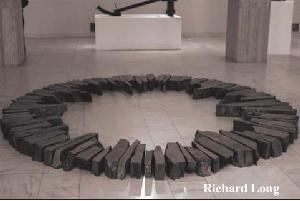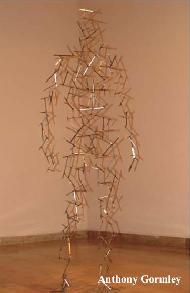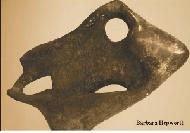 Brit Parade Brit Parade
TOXICWASTE that says I love you, PIECES OF OLD STONE on the floor and plastic kitchen linoleum in cones.
IS THIS A DERANGED DIY STORE or an impressive display ofUK sculptural talent?
The flyers advertising a
comprehensive summary of
modern British sculpture at the Romanian National Museum of Art
may be nothing more than bland
platitudes' the first major
retrospective of British sculpture ever
held in Romania', reads the PR fluff,
'includes artists that have contributed
significantly to the UK art scene', 'a
parallel to the Brancusi exhibition at
Tate Modern at the beginning of
2004'.
But the content is far from cliché.
'From Moore to Hirst' shows over 35
works that indicate Britain has been at
the forefront of sculptural
experimentation. For almost a
century, especially in its use of
original materials, artists have been
carving, cutting, moulding, forging,
welding and striking the scene while
the iron is hot.
The four chronologically-arranged
rooms show a pulsating, confident British vibe. The first room is the
throne room: Henry Moore and
Barbara Hepworth, the twin
monarchs of UK sculpture, set out a
libertarian constitution. Moore links
in well to another king of sculpture,
local boy Constantin Brancusi, in the
elegant primitiveness of its forms,
where his bronzes and cast concretes
make the passage from figurative to
ever more abstract sculpture, without
losing their authenticity. Hepworth,
meanwhile, wraps the void in
feminine curves cut in wood and
bronze.
 Next up are the members of the royal
court, discreetly breaking the rules set
out by the old masters. The laws of
disciplined stone carving and metal
casting are discarded in favour of the
'impertinence' of using linoleum,
found objects, timber and placing
them directly on the ground, with no
pedestal. Marking the clear passage
from Moore and Hepworth's classical understanding of the material, Paolozzi,
Anthony Caro and William Tucker do not
indulge the natural characteristics of the
materials, but dare to weld, paint and rearrange
their concepts. Complementing their
rather industrial view on sculpture, Tacita
Dean and Richard Long's works show a
simplicity and silence that do not disturb the
order of things. A prophet of land art, Long
borrows elements of nature to help them
express their original force - his Spring
Circle
, a series of individual pieces of slate
arranged in a sun-shaped ring, conjure up
feelings of a druidic mass.
Then come the royal offspring: the lunatic
son Damien Hirst and the adopted daughter,
Lebanese-born, but English-settled Mona
Hatoum. Hirst cuts to the bone, by collecting
toxic medical waste containers in a cage and
watching death flood in, but finishing off brit
with the title I'll love you forever. His Methods, approaches,
assumptions, results and findings show two glass and steel
tanks where ping pong balls are blown into the air like a
lottery held in Alice'sWonderland. Hatoum's Prayer mat is a
metaphor of searching for a home and meaning, a carpet of
needles whose compass is looking for Mecca. Next up are the members of the royal
court, discreetly breaking the rules set
out by the old masters. The laws of
disciplined stone carving and metal
casting are discarded in favour of the
'impertinence' of using linoleum,
found objects, timber and placing
them directly on the ground, with no
pedestal. Marking the clear passage
from Moore and Hepworth's classical understanding of the material, Paolozzi,
Anthony Caro and William Tucker do not
indulge the natural characteristics of the
materials, but dare to weld, paint and rearrange
their concepts. Complementing their
rather industrial view on sculpture, Tacita
Dean and Richard Long's works show a
simplicity and silence that do not disturb the
order of things. A prophet of land art, Long
borrows elements of nature to help them
express their original force - his Spring
Circle
, a series of individual pieces of slate
arranged in a sun-shaped ring, conjure up
feelings of a druidic mass.
Then come the royal offspring: the lunatic
son Damien Hirst and the adopted daughter,
Lebanese-born, but English-settled Mona
Hatoum. Hirst cuts to the bone, by collecting
toxic medical waste containers in a cage and
watching death flood in, but finishing off brit
with the title I'll love you forever. His Methods, approaches,
assumptions, results and findings show two glass and steel
tanks where ping pong balls are blown into the air like a
lottery held in Alice'sWonderland. Hatoum's Prayer mat is a
metaphor of searching for a home and meaning, a carpet of
needles whose compass is looking for Mecca.
When the British Council meets the Romanian National
Museum of Art on the latter's ground, it becomes a place of
perdition: by losing rigid concepts and other artistic clichés ish
in favor of a freer understanding of sculpture.An inhalation
of cold British air, intoxicated by a mouthful of smog,
never hurt anyone. Go to this gallery, take a long, deep
breath and make your acquaintance with a “How do you
do?”
But with a stiff upper lip.
Anca Pol
|


|